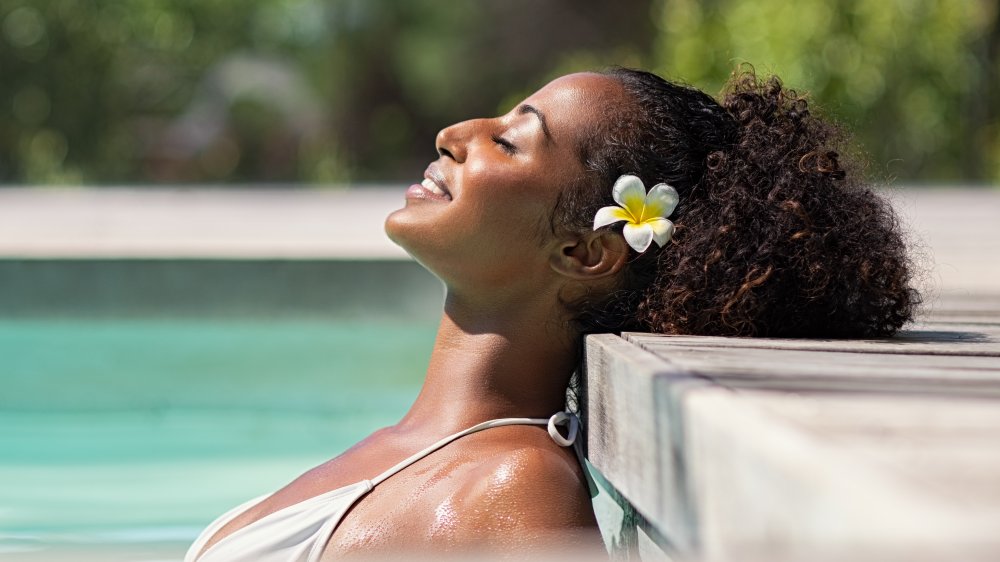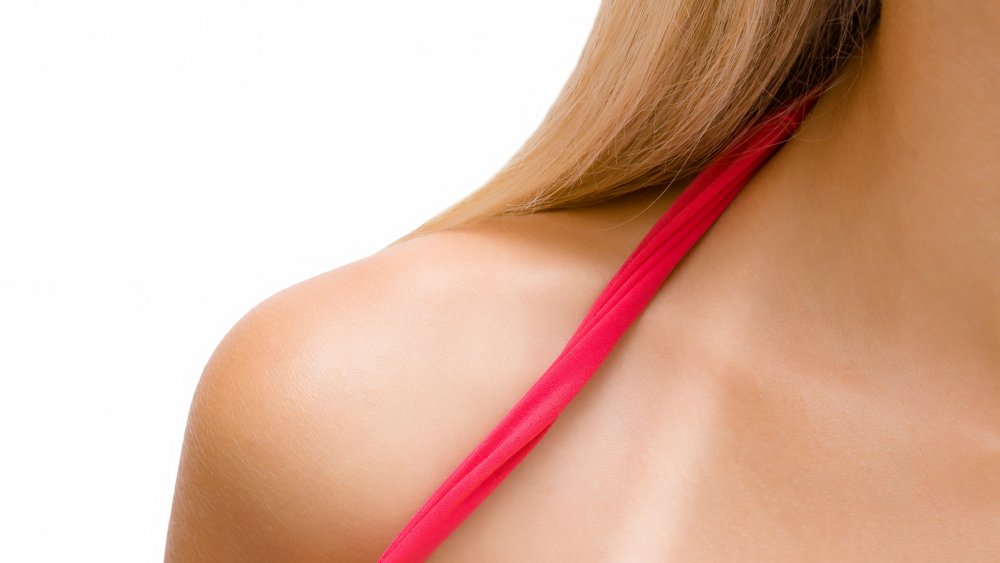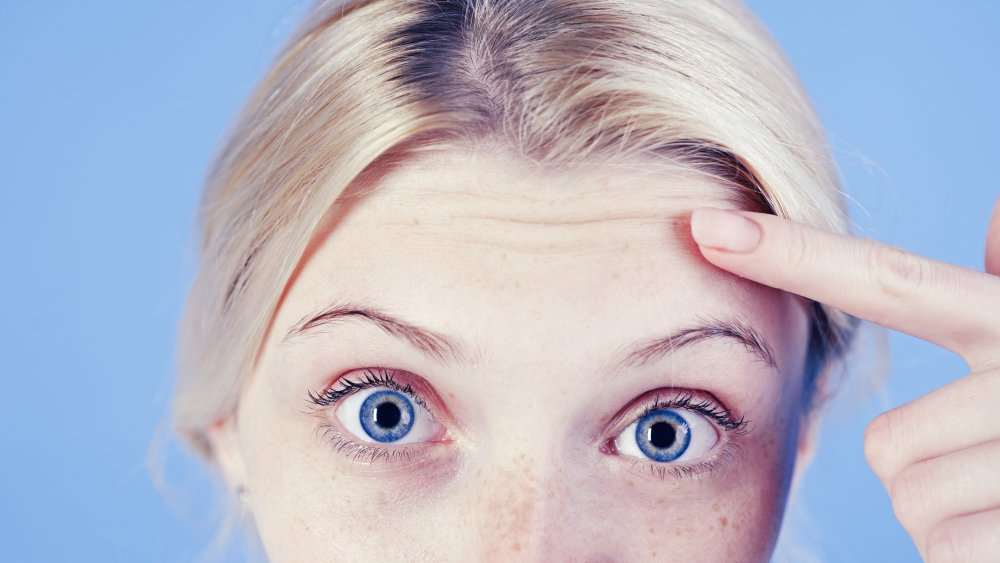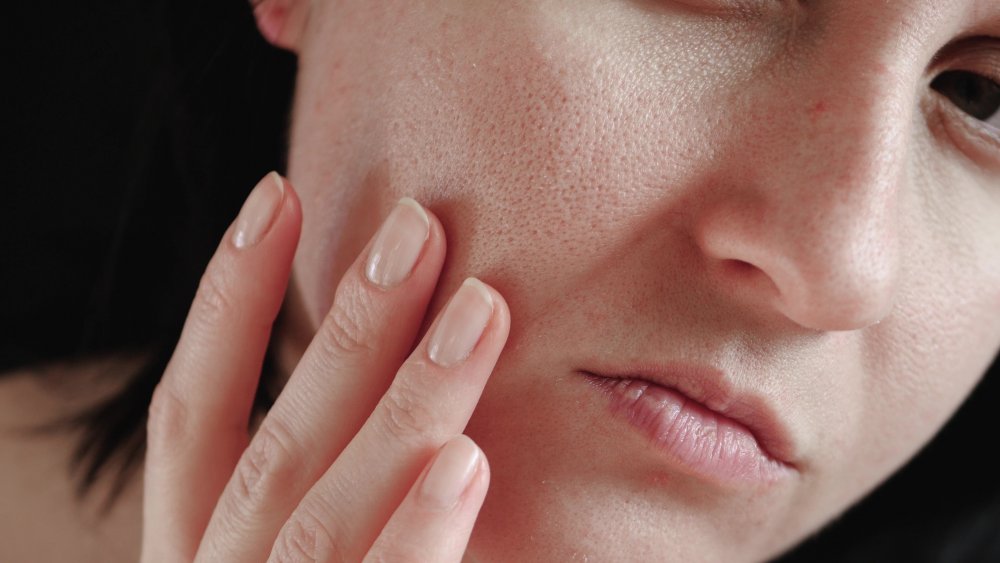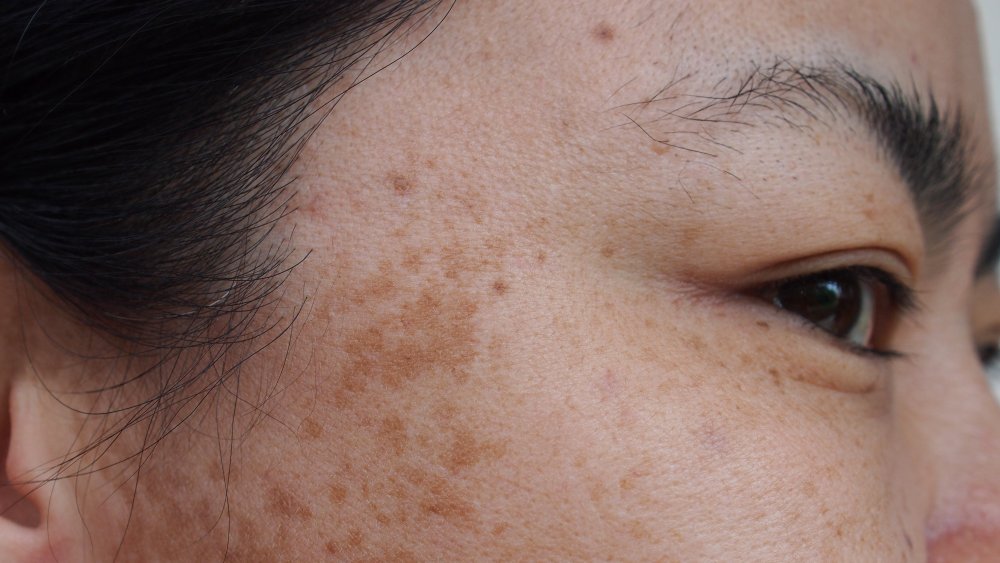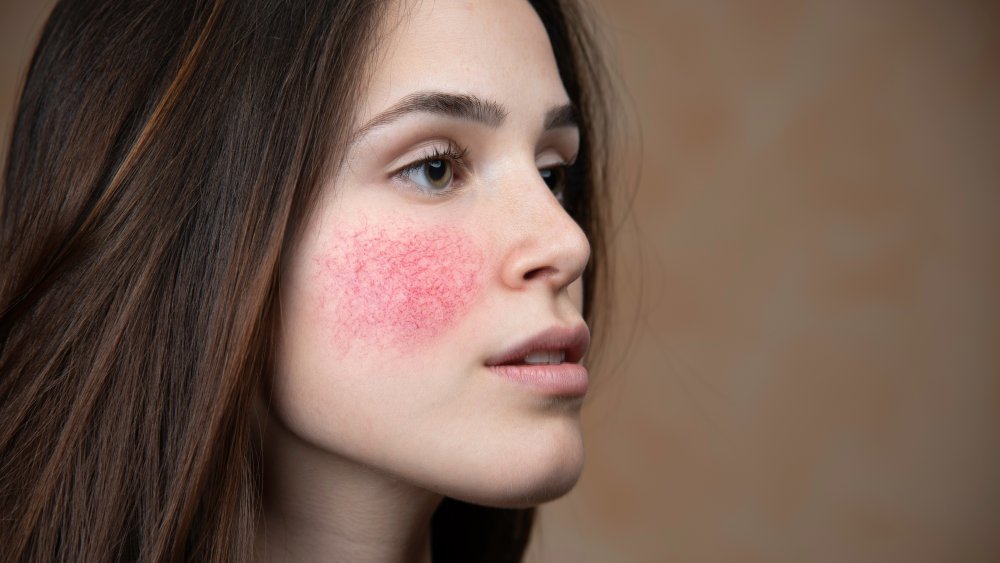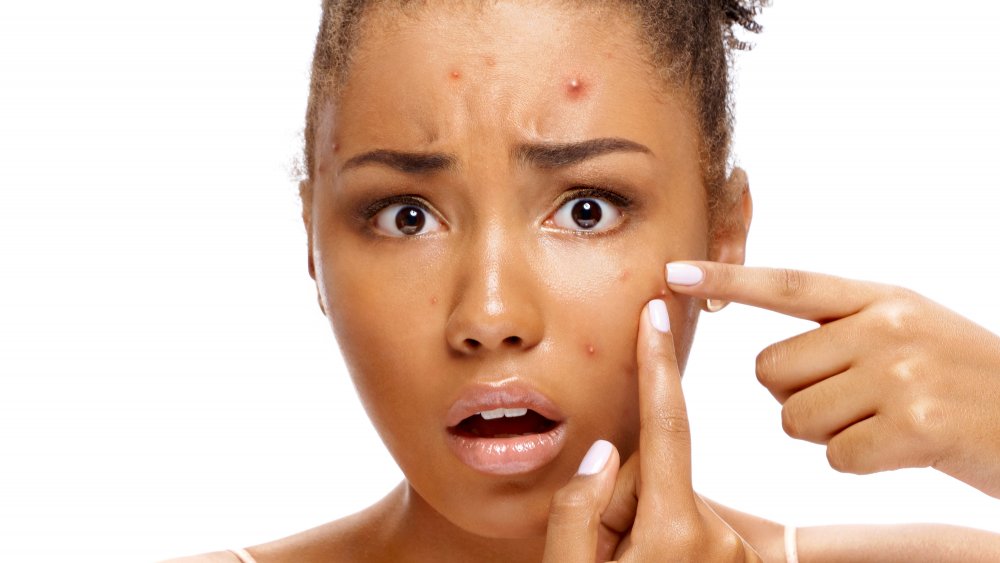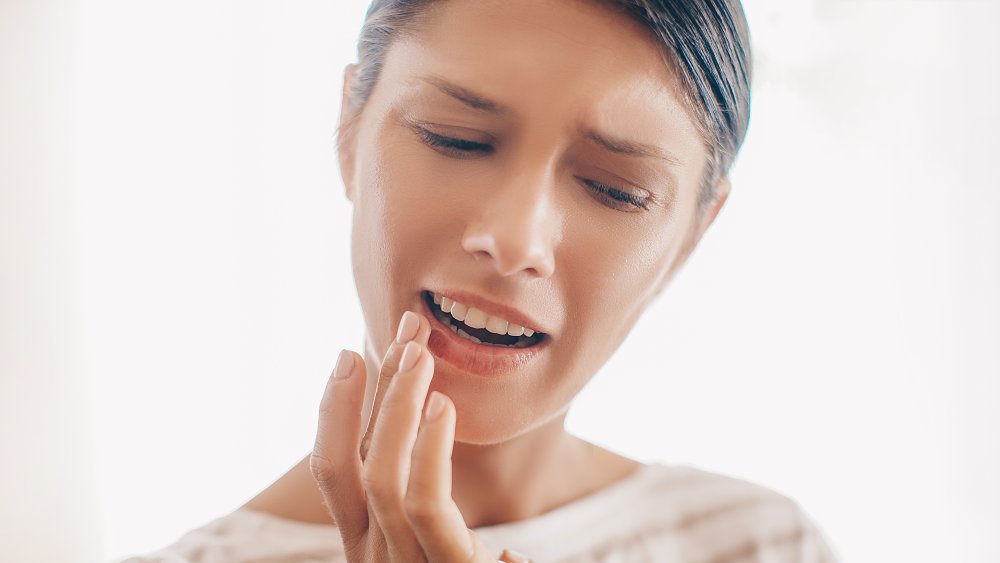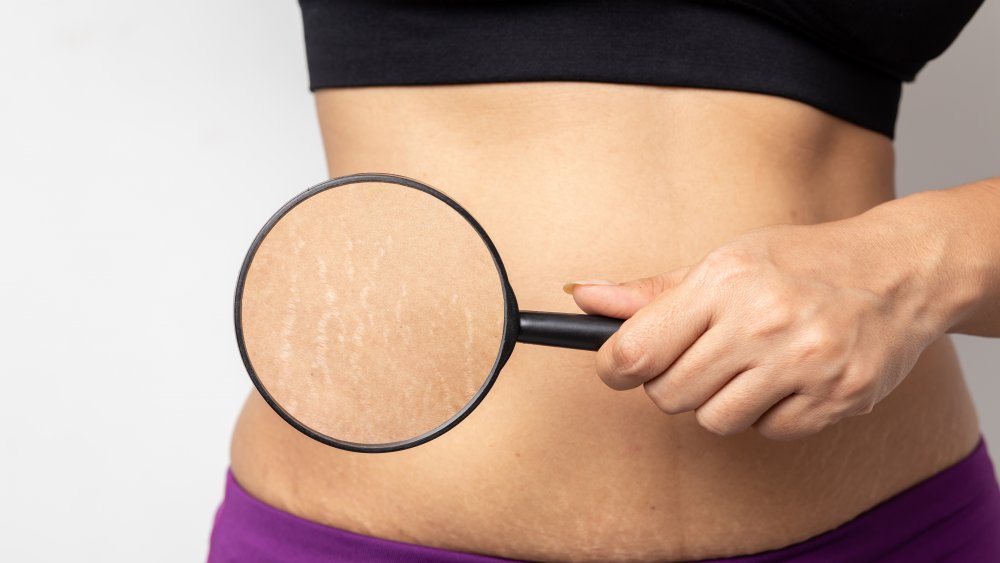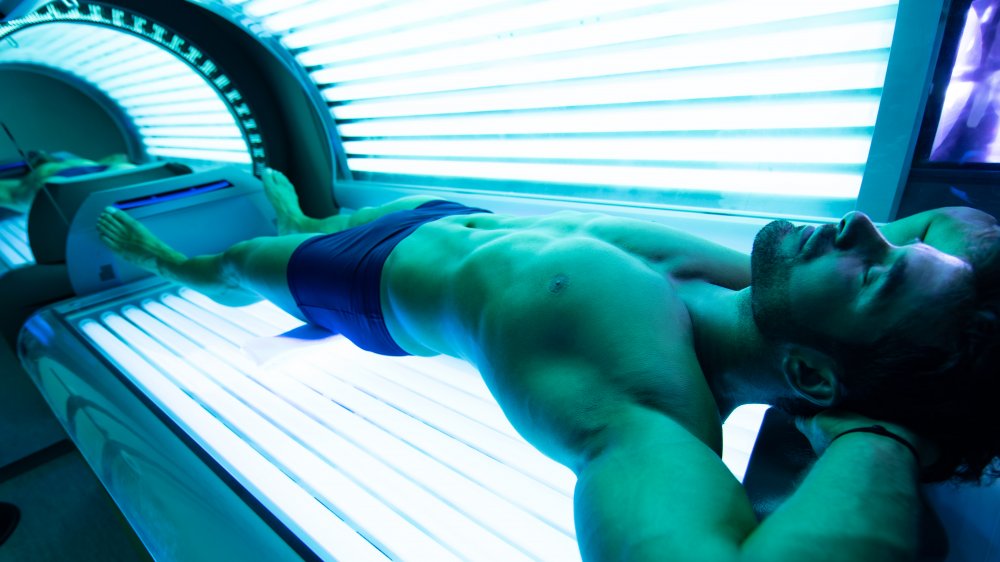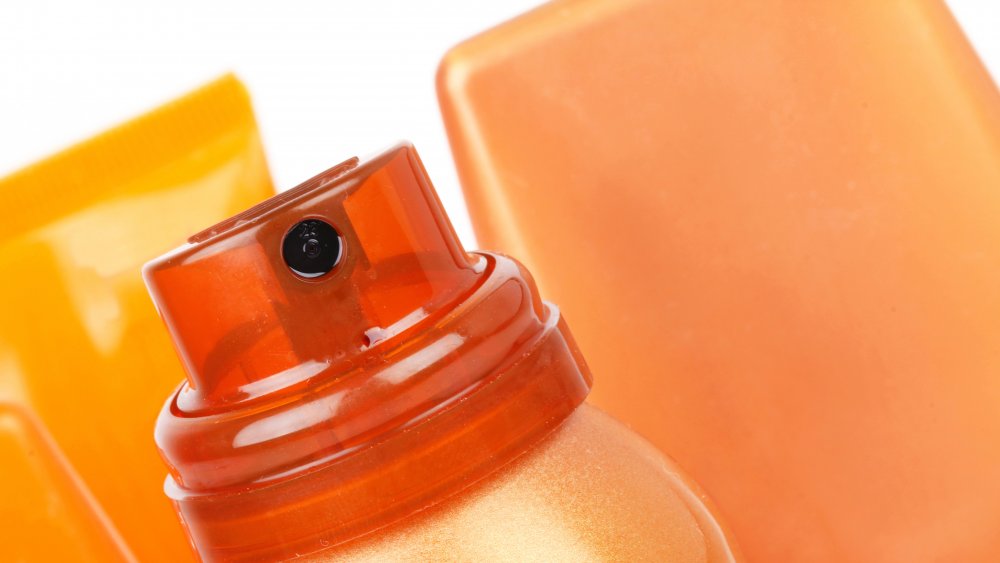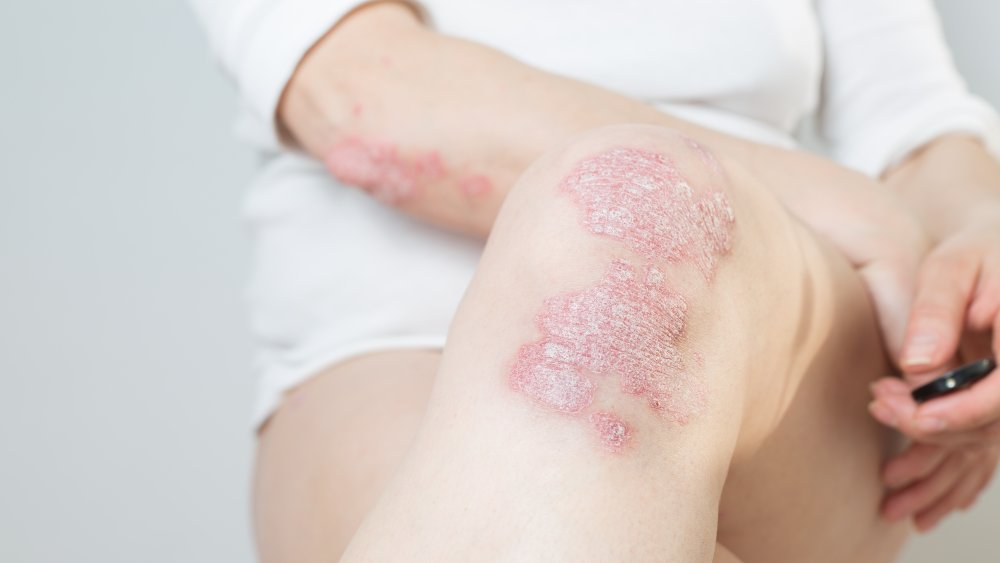What Getting A Tan Really Does To Your Skin
Have you ever spent hours tanning in the sun, hoping to build up a glow but ended up with a painful sunburn instead? If you are nodding in agreement, you are not alone. According to a 2020 survey by the American Academy of Dermatology, most Americans have gotten a sunburn severe enough to interfere with daily life.
Most of us know that sunburns are bad for the skin. Less known is the fact that getting a tan carries similar risks, even if you don't burn. The sun emits ultraviolet (UV) radiation that damages living tissue. Fur, feathers and scales protect the skin of non-human animals against the sun. But as we're thought to have lost most of our body hair in the course of evolution, we are left vulnerable to the sun's harmful effects.
Our ability to get a tan seems to be nature's way of making up for the loss of protective hair, but it's actually damaging. "The skin tries to prevent further injury by producing melanin (the pigment that gives our skin its color) that results in darkening — what we call a tan,' the Skin Cancer Foundation revealed. That's not all that happens to your skin when you tan. Here's a look.
This is how your skin becomes tanned
When you expose your skin to the sun without a sun blocker, like sunscreen, specialized skin cells called melanocytes produce the pigment melanin — and it's melanin that causes your skin to darken.
Okay, it is a little more complicated than that. There are, in fact, two types of melanin: blackish-brown eumelanin and reddish-yellow pheomelanin. The natural color of your skin and your skin's ability to darken depend on whether your melanocytes produce mostly the blackish-brown or the reddish-yellow pigment. The more of the blackish-brown pigment you naturally have in your skin or produce when sunbathing, the darker your natural or tanned skin color.
The reddish-yellow form of melanin is predominant in fair-skinned and red-haired people, which can make it difficult for them to build up a tan. It also leaves them at a higher risk of experiencing skin damage from sunlight than people with a darker, natural skin tone.
A tan is evidence of skin damage
Many people believe that simply avoiding sunburns while tanning will protect them against the sun's harmful effects. But as Madeliene Gainers, Florida-based dermatologist, told Healthline, this belief is mistaken. "A tan in and of itself is evidence of skin damage," she explained. Yes, if you've ever tanned, you may already have skin damage.
To understand this, let's take a closer look at sunlight. Sunlight contains two types of ultraviolet rays: UVA and UVB. According to the Skin Cancer Foundation, UVA is much more abundant than UVB, accounting for 95 percent of the sun's UV radiation. UVB mainly penetrates the outer layer of your skin, known as the epidermis, and is the primary cause of sunburns.
UVA, on the other hand, penetrates your skin more deeply, reaching far into the thick middle layer, called the dermis. Because UVA reaches deeper into your skin and is more abundant than UVB, it's the greater risk factor for chronic skin damage. This means you should protect yourself against both UVA and UVB rays as well avoid both sunburns and suntans.
Tanning ages your skin faster
While melanin, the skin pigment that gives your skin its color, can help protect it against the sun's dangerous rays, melanin is not an impenetrable shield. UV rays that are not absorbed can cause skin damage, according to MedlinePlus. One way is by destroying its collagen and elastin fibers, the fibers which serve to support your skin and keep it elastic.
In a 2018 study published in the journal Cosmetics, a team of researchers looked at how UVA and UVB rays affect collagen in a laboratory model of human skin. They found that both kinds of ultraviolet light caused destructive changes to the skin's collagen. Healthy skin can repair these damages, but when UV radiation impairs the collagen in the dermis over and over again, the rebuilding process becomes less efficient, and eventually the collagen will be unable to support your skin properly.
Without this support, your skin will no longer be able to retain its youthful smoothness and plumpness. The result is sagging skin, fine lines, and wrinkles. Getting a tan can thus make you look older before your time. This is also known as "photoaging."
Tanning can lead to enlarged pores
Working on getting a tan can also cause skin pores to become enlarged, especially on your nose and the middle parts of your cheeks and forehead. Pores, regardless of size, are normal structures in your skin, but when they grow bigger, they become noticeable and may present a cosmetic problem.
Several factors can cause an enlargement of your pores, including acne, advanced age, increased secretion of sebum (a yellowish, oily substance produced by glands inside all your skin pores), according to Medical News Today. And, of course, sun exposure can increase pore size.
While it remains unknown how exactly repeated exposure to the harmful radiation of sunlight can result in enlarged pores, it's thought that sun damage to the collagen and elastin in your skin causes your pores to open up, The Healthy explained. Interestingly, a 2018 study published in Skin Research and Technology also found that "enlarged pore counts were related to wrinkle severity."
Tanning can darken café-au-lait spots and cause sunspots
Too much sun exposure can darken café-au-lait spots, which are large, flat, light brown spots, occurring on the face or body, Healthline explained. While they are microscopically indistinguishable from freckles, they form substantially larger continuous or discontinuous shapes. They are not harmful, although they can be a sign of a more serious condition when they occur in large numbers in young children. While café-au-lait spots are often referred to as birthmarks, they are usually not present at birth but appear over several years, according to Boston Children's Hospital.
Sun exposure can also give rise to actinic keratosis, or what is also known as sunspots. Sunspots are rough, scaly and discolored, and appear on the face or other body parts that have been jeopardized by sunlight. An estimated 10 percent of sunspots become skin cancer, if left untreated. Although sunspots can have the same color and size as café-au-lait spots, you can tell the difference by the scab-like feel of sunspots.
Tanning exacerbates rosacea
Tanning can lead to worsening rosacea, an inflammatory skin disease characterized by facial redness, red bumps, and small visible blood vessels. According to a 2018 review in F1000 Research, rosacea affects more than 16 million people in the United States alone. Rosacea is more common among women ages 30 to 60 and people with fair skin.
Research indicates that sunlight can trigger a rosacea patient's immune response, making the skin more susceptible to bacteria and skin mites, also known as Demodex mites. As creepy as it sounds, pretty much everyone has these mites residing on their skin, but skin affected by rosacea has been found to contain an elevated density of these mites. Still, it's unclear whether mites actually contribute to the condition.
Either way, you'll want to take extra precautions if you have rosacea, like staying out of the afternoon sun and wearing sunscreen. "Just a few minutes of sunlight on rosacea-prone skin can lead to uncontrollable flushing and redness," the American Academy of Dermatology Association cautioned.
Tanning can cause acne breakouts
If you are prone to acne, you may think that tanning can help clear up your skin. This, however, doesn't appear to be the case. While UVA light has antibacterial and antiviral effects when used to disinfect objects and surfaces, there is no evidence that it improves acne. In fact, as Wake Forest Baptist Health revealed, sunbathing without sunscreen can irritate your skin and cause your acne to flare up.
If you have acne-related hyperpigmentation, a condition in which a dark spot or patch appears when a pimple resolves, you have another reason to avoid tanning. As tanning involves a darkening of the skin, it can make hyperpigmentation far more noticeable (via Medical News Today).
Frustratingly, sunscreen can also exacerbate your acne by clogging your pores. To protect your skin against the detrimental effects of sunlight without aggravating your acne, Rady Children's Hospital-San Diego recommends that you look for "a sunscreen with a sun protection factor (or SPF) of at least 30 that's labeled 'noncomedogenic' or 'nonacnegenic,' which means the product won't clog pores."
Tanning can lead to an outbreak of cold sores
Tanning can trigger an outbreak of cold sores, or oral herpes. Cold sores are typically caused by the herpes simplex virus type-1 (HSV-1), although they can occasionally be caused by herpes simplex virus type-2 (HSV-2), the primary culprit in genital herpes. Because the viral DNA remains permanently in the body, even when the cold sores have healed, people infected with the virus often suffer from recurrent infections, or what is also known colloquially as outbreaks, The Healthy explained.
One of the main triggers of a herpes outbreak is the sun's ultraviolet rays. According to a 2018 review published in Human Herpesvirus Infection, UV radiation triggers an outbreak by impairing the skin's immune system, which otherwise would have been able to keep the viral DNA in a dormant state. The skin on the lips and inside the mouth is particularly vulnerable to infections, because it lacks a top protective layer of dead skin cells.
As board-certified dermatologist S. Manjula Jegasothy explained to The Healthy, the best way to prevent an outbreak of cold sores as a result of sun exposure is to use lip balms that contain SPF before venturing into the sun, and reapplying hourly.
Tanning can make stretch marks more noticeable
Stretch marks are scars that can show up on skin that's been stretched a lot over a relatively short period of time or has been stretched beyond its limits. When skin is stretched too far or too rapidly, the collagen and elastin fibers in the skin's dermis are torn apart. This can lead to scarring in the form of visible stretch marks. According to the American Academy of Dermatology, common causes of stretch marks include growth spurts in puberty, pregnancy, and rapid or extreme weight gain or weight loss.
Like other scars, stretch marks don't tan. So, when you get a tan, the skin surrounding the stretch marks will darken while the stretch marks will remain pale, making them more noticeable. Stretch marks are very common and nothing to be ashamed of. But if you want to disguise these marks, there's no shame in that either.
Unlike a natural tan, sunless tanning products, such as self-tanning lotion, can mask stretch marks. As the active ingredient in self-tanners binds to dead cells on the surface of the skin, these products will darken both the scar tissue that makes up the stretch marks and the surrounding skin.
You increase your risk of skin cancer when you tan
Skin cancer is the most common type of cancer in the United States, accounting for 40 to 50 percent of all diagnosed cancers, and its primary cause is exposure to sunlight. Both UVA and UVB radiation can give rise to skin cancer by causing the DNA in your skin cells to mutate. As noted by Healthline, skin cancer occurs when DNA mutations lead to uncontrolled cell divisions that starve healthy tissue to death.
The three main types of skin cancer are basal cell carcinoma, squamous cell carcinoma, and melanoma. They are all cancers of the epidermis. Basal cell carcinoma is cancer of the basal cells, small round cells forming the innermost layer of the epidermis. While this is the most prevalent of all skin cancers, it's also the one least likely to be fatal, as it's slow to multiply and rarely spreads. Squamous cell carcinoma, or SCC, is cancer of flat, scale-like cells, called squamous cells. Up to 5 percent of squamous cell carcinomas spread to other parts of the body, which makes it more dangerous than basal cell carcinoma. Finally, melanoma is a cancer of the cells that produce melanin. Though rarer than other skin cancers, it is by far the deadliest type.
Tanning beds are particularly dangerous
Tanning beds, or sun beds, are machines fitted with UV lamps that emit ultraviolet radiation. A typical tanning bed emit mostly UVA and some UVB rays, much like the actual sun. Tanning beds thus produce a tan in the same way as the sun, but they do so much faster. "It's estimated that 10 minutes in a tanning bed matches the cancer-causing effects of 10 minutes in the Mediterranean summer sun," the Skin Cancer Foundation revealed. According to the foundation, the dose of UVA used in tanning beds can even be up to 12 times greater than the dose you would receive by sunbathing outdoors.
Because of the high dose of UVA rays emitted by tanning beds in a single session, getting a tan from a tanning bed is far more dangerous than getting one outdoors in natural sunlight. The American Academy of Dermatology explained that indoor tanning can drastically increase your risk of developing skin cancer. Just one indoor tanning session increases the risk of basal cell carcinoma by 29 percent, squamous cell carcinoma by 67 percent, and melanoma by 20 percent.
Does a risk-free tan exist?
The safest way to get a tan is by using a sunless tanning product, such as a self-tanning lotion, cream, or spray. A self-tanner can give your skin that sun-kissed look without exposing it to dangerous ultraviolet rays.
Most sunless tanning products contain the color chemical dihydroxyacetone (DHA), which has been approved by the Food and Drug Administration for application to the skin. As noted by the Mayo Clinic, DHA interacts with dead cells in your skin's surface layer, resulting in a darkening of your skin that resembles a sun tan. It doesn't interact with any living cells in your skin, and it doesn't have any of the harmful effects of sunlight or tanning beds.
To get a natural-looking result with a sunless tanning product, you need to apply the product evenly across your skin. If you are having difficulties getting an even skin tone, you may consider making an appointment with a professional tanning salon specializing in spray-on tanning. Whether you apply the product yourself or get a professional spray tan, your tanned look will slowly fade as you shed dead skin cells. Your tan will most likely completely wear off within a few days.
Some skin diseases may benefit from sun exposure
It is, of course, a good idea to protect yourself from the UV rays of direct sunlight by using sunscreen or covering yourself with clothing. However, as reported by a 2017 review in Photochemical & Photobiological Sciences, sunlight in moderate doses can have beneficial effects on the skin of people who have psoriasis or other similar autoimmune skin diseases.
Psoriasis is a skin disorder that causes skin cells to multiply up to 10 times faster than in other individuals, resulting in a build up of red, itchy, scaly patches of skin, most commonly on the scalp, elbows, or knees. Psoriasis tends to go through phases, flaring up for a couple of weeks or months, and then going into remission. Like other autoimmune skin diseases, psoriasis is caused by the immune system reacting to its own skin cells as if they were foreign invaders. As such, the skin cells are killed off at an alarming rate. The spared skin cells react to the trauma by dividing at a faster pace.
Thankfully, sunlight may provide some relief. Still, Healthline recommends applying "broad-spectrum sunscreen to all areas of unaffected skin" and only exposing the skin to the sun for 10 minutes at a time.


